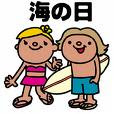:::::::::::::::::::::::::::::::::::::::::::::::::::::::::::::::::::::::::::::::::::::::::::::::::::
Flower Exchange Festival (hanakae matsuri)
***** Location: Kanegasaki Town, Tsuruga City
***** Season: Late Spring
***** Category: Observance
*****************************
Explanation
Flower-exchanging festival 花換祭 / 花換祭り
はなかえまつり / はなかへまつり
Fest zum Austausch von Kirschblütenzweigen
 This festival takes place from the first to 15th of April at the town of Kanegasaki, in Tsuruga City 敦賀, Fukui Prefecture.
This festival takes place from the first to 15th of April at the town of Kanegasaki, in Tsuruga City 敦賀, Fukui Prefecture.Shrine Kanesakiguu 金ヶ崎宮
金ヶ崎 花換え祭り
This shrine is famous as a location of the battle between Nitta Yoshisada and the army of the Ashikaga shogun in the Nambokucho period.
The stone stairs up to the shrine are 92 KU NI, meaning "to have no worries" and you have to run them up to get rid of your worries.
It is one of the great cherry blossom viewing points of the area, with more than 1000 somei yoshino cherry blossoms trees and a splendid view over the port of Tsuruga.
People come to enjoy the blossoms, eat some yakitori and sweet potatoes (for a sweet love life ) prepared by the "seinen kurabu" (now they are elderly men, but work hard to keep the little community alive).
You buy an artificial branch with cherry blossoms at the shrine office and are free to exchange it with anyone you fance, smiling and saying "Let us exchange flowers!" This is now a great spot for young lovers.

Young "luck-bringing girls" (fuku musume 福娘) sell the branches in the street too.
Another speciality are the
"Cherry blossom cookies",
sakura kukkii 桜クッキー

They are round cookies with one cherry blossom in the middle and only sold during the festival.
:::::::::::::::::::::::::::::::::::::::::::::::::::::::::::::::::::::::::::::::::::::::::::::::::::
Festivals where things are exchanged
by Mogi Sakae
usokae shinji , Bullfinch-exchanging rite.
A rite held during the night of January seventh at the shrine Dazaifu tenmangū in Dazaifu City, Fukuoka prefecture. Bullfinches (uso) made of wood are used as charms against fire. People take their bullfinches that are covered with the preceding year's grime to the Tenman shrine, and everyone exchanges bullfinches with anyone else freely, saying "kaemashō, kaemashō " ("Let's trade, let's trade"). During this excitement the shinshoku (shrine priests) lose themselves among the crowd of worshippers and walk about surreptitiously passing out the shrine's twelve bullfinches. Those who get one of the gold bullfinches are said to receive good fortune for the year.
The festival called onisube, famous for protection from fire, is observed after the bullfinch festival. Two groups of nearly one hundred people each are divided into the "demon guards" and the "smoke handlers." The latter light a huge mound of fresh pine piled up outside of the shrine hall with sacred fire (or by rubbing two sticks together), and fan the smoke into the shrine with an enormous fan. On the inside the demon guards beat the slat board walls with wooden mallets. Then, drawn by torches, the smoke-covered demons try to go around the shrine, but the shrine priests throw parched beans at them. People strike the demon masks that the performers wear with staffs called utsue. After going around the outside and inside of the shrine through the smoke and ash the demons come to a stop.
The usokae shinji at the shrine Kamadotenjinsha in Kōtō-ku, Tokyo is said to have been brought from Dazaifutenmangū.
On January fifth there is an usokae matsuri also at the shrine Meihamatenmangū in Fukuoka City, Fukuoka prefecture. Similar to the bullfinch rites is the hatokaeshi shinji (dove-exchanging rite) at the shrine Usajingu in Usa City, Ōita prefecture.
There is a tamakaeshi matsuri (gem-exchanging festival) on January twenty-first in which tama gems are traded at Miyajidake Jinja, Munakata-gun, Fukuoka prefecture.
In addition, there are festivals such as the okinjokaeshi matsuri in Hinagu, Ashikita-gun, Kumamoto prefecture, in which dolls are traded,
and the hanakae matsuri (flower-exchanging festival) at the shrine Kanezakigū in Tsuruga City, Fukui prefecture.
source : Mogi Sakae / eos.kokugakuin.ac.jp
. . . . .
Usokae うそ替え / 鷽替え exchanging carved bullfinches
. kiku kuyoo 菊供養 memorial ritual for chrysanthemums .
Asakusa Kannon Temple, Tokyo
People by one chrysanthemums offered at stalls and persent it on the altar as an offering to the Kannon deity.
Then they take a flower which had been offered by someone else and take it home. This is their amulet for warding off evil influence in the coming year.
*****************************
Worldwide use
*****************************
Things found on the way
Other forms of "Cherry blossom cookies"
sakura kukkii 桜クッキー



CLICK for more English information



*****************************
HAIKU
:::::::::::::::::::::::::::::::::::::::::::::::::::::::::::::::::::::::::::::::::::::::::::::::::::
*****************************
Related words
***** WASHOKU
Japanese Sweets Saijiki
::::::::::::::::::::::::::::::::::::::::::::::::::::::::::::::::::::::::::::::::::::::::::::::::::















